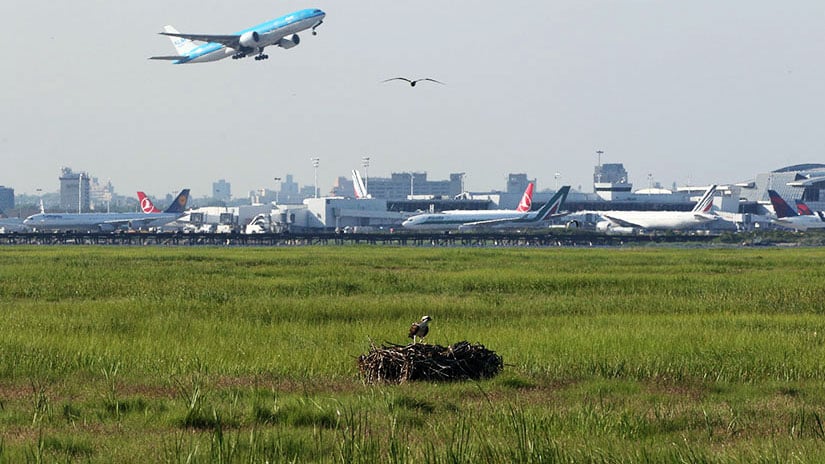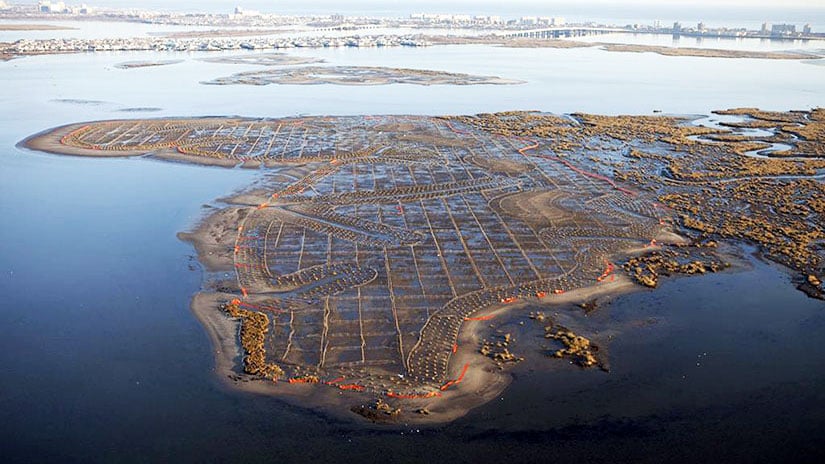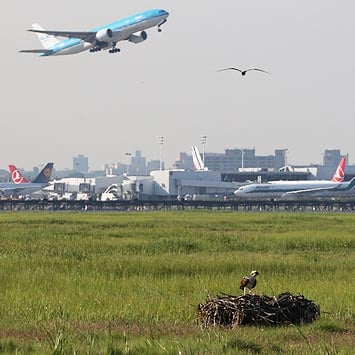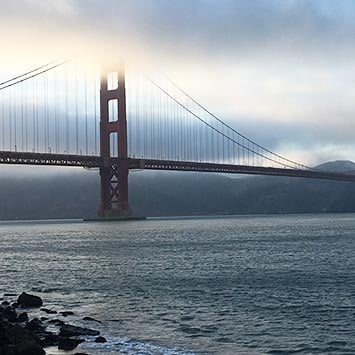Jamaica Baywatch | New York
If you take the ‘A’ train to the end of the line in Queens, you land at Jamaica Bay, where salt marshes support endangered birds and rare turtles. We patrolled these waters with an activist known as the Jamaica Bay Guardian.
Coexistence is a fact of life in New York City’s Jamaica Bay.
Wetlands swarming with wildlife share the bay with urban communities: Colonies of birds soar next to roaring jets taking off and landing at John F. Kennedy Airport, diamondback terrapin turtles paddle alongside powerboats, and a salt marsh is bisected by a subway line.
Jamaica Bay’s vast tidal salt marshes provide critical wildlife habitat and offer barriers against storm surges. But they are washing away at startling rates as a result of pollution and rising sea levels. According to the United States Army Corps of Engineers, approximately 1,400 acres of tidal salt marsh have been lost in Jamaica Bay since 1924 and the marsh islands could disappear entirely in less than a decade.
When Hurricane Sandy came crashing into New York City in 2012, several of the bay’s marshes were severely eroded, including the 10-acre Rulers Bar Marsh.
Jamaica Bay residents and volunteers have stepped in, along with local, city, and state agencies, to restore the bay’s saltmarsh islands and build new marshlands. Following the storm, the Army Corps of Engineers pumped tons of dredged sand on and around Rulers Bar Marsh. Volunteers then fenced-in the area and began planting habitat in the form of native smooth cordgrass, also known as Spartina alterniflora.
“Spartina plant is a terrestrial plant that’s adapted to salt water, so it outcompetes everything else, which is why you only see one plant,” local environmental activist Don Riepe said. “It is one of the most productive habitats here. All of the nutrients that are locked in there, all of the food it provides to all of the bay fish, the marine life—crabs, mussels, clams—all of the birds that feed on the plant. It’s also nursing grounds for the finfish that we eat. In the early part of their lifecycle they hide in the marshes, they feed in the marshes, and the marshes are protected nursing grounds for them. It’s incredibly important to habitat.”
Riepe has called Jamaica Bay home since 1981 and has been patrolling the bay as the official Jamaica Bay Guardian for the Northeast Chapter of the American Littoral Society since 2003.
“My role is to be a watchdog out here,” Riepe explained. “To patrol the bay, let the Department of Environmental Conservation know what’s happening around the bay, to work with all of the agencies and all of the restoration projects. They do environmental programs, educational programs, it’s been a fun position to take.”

For the past 4 years, Riepe has been leading volunteer and youth groups out to Rulers Bar Marsh as part of a Marsh Restoration Initiative. During the first year of Rulers Bar restorations, volunteers gathered spartina seeds, shipped them to New Jersey for cold-storage during the winter, and then planted the seeds in peat pots before transferring the plants to the marsh.
To date, volunteers have individually planted about 150,000 plugs of spartina plants at Rulers Bar Marsh and are currently working on an even bigger restoration project at the bay’s 20-acre Black Wall Marsh.
“We tied the community into restoring the whole bay,” Riepe said. “We want to continue this. We’re going to move on to the next marsh and the next marsh in hopes that we can stabilize the bay at the same time when the city hopefully reduces the amount of nitrogen coming into the bay, which we feel may be the main culprit for marsh erosion.”
Scientific studies have shown that one of the factors leading to the decline of the salt marshes is nitrogen pollution. Thousands of pounds of nitrogen is discharged daily in the bay by four local city sewage treatment plants.
In 2011, an agreement was signed between the Natural Resources Defense Council, the city and state, and environmental groups to cut nitrogen discharges in half from the treatment plants by 2020. Under the agreement, the city is paying $100 million to upgrade technology at the plants, including the installation of an ammonia recovery system at the 26th Ward Wastewater Treatment Plant.
In addition to pollution, sea level rise is also playing a major role in the deterioration of Jamaica Bay’s salt marshes.
“We’re now getting 7-foot tides,” Riepe said. “Ten to 15 years ago, it was always 6’10’’, 6’11”, now it’s 7’1”, 7’2”. Every decade or two there’s another inch-and-a-half of water, which increases dangers of flooding.”
Riepe experienced major flooding during Superstorm Sandy when a 14-foot surge of water brought nearly 6 feet of bay water into his home on the narrow island of Broad Channel. As a result of the storm, Riepe had to replace walls, floors, appliances, furniture, and more, and he raised the floors throughout his property for future flood protection.
“We’re vulnerable here,” Riepe said. “It was a shock to the community, but people rebuilt. People want to live on the coast, they want to live here, they were born here, they have family here.”
All around Broad Channel homes are being raised 10 feet off the ground as part of a city-funded “Build it Back” program. In addition to shoring up houses, three of the community’s low-lying residential roadways are being elevated 2 1/2 feet with added bulkheads to prevent high tides from flooding the neighborhood’s narrow streets.
Prior to taking on his role as the Jamaica Bay Guardian, Riepe worked as a ranger for the National Park Service for 20 years, where he still serves on a task force that is studying ways to make JFK Airport less attractive to birds.
“Birds and airplanes don’t mix too well,” Riepe explained. “The bay is a great resource to have next to an urban center, but also a great wildlife refuge because of its location right on the Atlantic Coastal Flyway. So you have millions of birds flying back and forth each year, and they rely on these stopovers. Even if they don’t live here, they stop, and feed, and rest. And then there’s a whole pageantry of birds that use the bay year-round. The challenge is to coexist.”
JoCo Marsh is the biggest and most well-preserved salt marsh in Jamaica Bay. Immediately adjacent to JFK Airport, the marsh provides visitors with exceptional views of laughing gulls, herons, great egrets, and other feeding shorebirds. JoCo offers a combination of low and high marshes, which Riepe said is ideal for spartina to thrive.
Amidst the music of songbirds and cricket choruses harmonizing with the roar of subway trains and jet engines, Riepe stops on JoCo Marsh to photograph a rare sea lavender plant before boating back to Broad Channel.
“I just think the marshes are beautiful,” Riepe said. “There’s emerald green in the middle of the bay and it’s full of life. The thing that’s special about it to me is, here you have this beautiful natural resource, you have a plane coming into Kennedy Airport, you have New York City’s skyscrapers there—so you have this urban refuge in the middle of all of this development, and still it’s functioning very well.”

— Sean Keenehan






